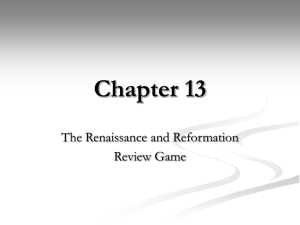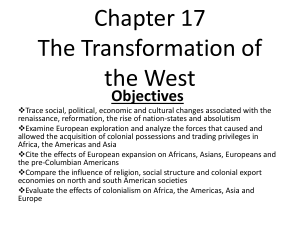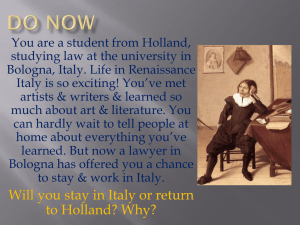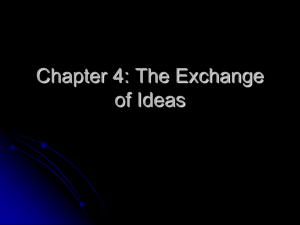The Renaissance & Reformation
advertisement
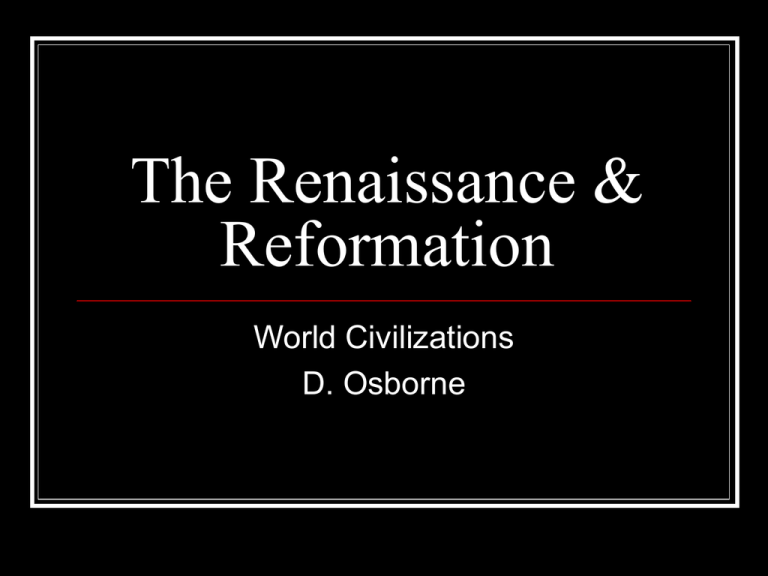
The Renaissance & Reformation World Civilizations D. Osborne ENTE Groups Experimental Note Taking Exercise (yes you ARE my lab rats). Group According to Suit (♠ ♣ ♥ ♦). Answer each question according to your suit (if no suits are assigned answer all questions). Everyone take notes (this is all test material). Video Part I What is humanism? Compare Renaissance humanism to Medieval introspection. Compare and contrast Medieval and Renaissance art. ♠ ♣ What was the condition of the Roman Catholic Church at the time the Renaissance began? ♥ ♦ What was the relationship between the popes and Europe's secular rulers at that time? True & False (correct False statements) 1. The Renaissance was a period of cultural rebirth. _______ 2. ♦The leaders of the Renaissance were inspired by ancient cultures. _______ 3. ♥The study of humanism was important during the Renaissance. _______ 4. ♣During the Renaissance, painting became more threedimensional. _______ 5. ♠The Renaissance began in England. _______ FITB 1. The Renaissance began in _________________ in the early to mid- ____________. 2. ♦ The period between the fall of Rome and the Renaissance is called the ________ ______, or ________________ era. 3. ♥ The Renaissance period ended roughly around _________. 4. ♣ The glorification of the human body by Renaissance artists may have helped inspire scientists to study _____________. 5. ♠ Wealthy supporters of artists, musicians, scholars, and scientists are called _________. Potential Essay Question: (discuss form of the essay) What big shift in thinking (away from Medieval patterns) occurred among the leaders of the Renaissance and how did the classical civilizations of ancient Greece and Rome influence them? More T & F 1. During the Renaissance, a unified Italian nation did not exist. _______ 2. ♦ The Dark Ages occurred during the last part of the Medieval era. _______ 3. ♥ The Renaissance began in northern Spain. _______ 4. ♣ Humanism is the study of God. _______ 5. ♠ Perspective was rarely used in Medieval art. _______ Applied Vocabulary: 1. _______________ uses rational rather than religious ways to try to solve human problems. 2. ♦ One way to create the illusion of three dimensions on a flat surface is to use __________. 3. ♥ The study of the structure of bodies carried out by performing dissections is called _______. 4. ♣ The Romans called England _____________. 5. ♠ During the Renaissance, the ____________ owned the largest banking empire in Europe. Video 2 – T & F 1. During the Renaissance, an astronomer named Galileo proved that the earth is at the center of the universe. ________ 2. ♦ The Reformation movement that occurred during the Renaissance tried to reform criminals.________ 3. ♥ Before the Renaissance, books had to be copied by hand, one at a time. ________ 4. ♣ Vasco da Gama was a Portuguese explorer. ________ 5. ♠ During the Renaissance, most explorers were searching for new continents. ________ FITB 1. 2. 3. 4. 5. During the Renaissance, Martin Luther sought to ______________ the Roman Catholic Church. ♦ Johannes Gutenberg's invention of __________________ helped speed up the rate at which new information could be spread. ♥ During the Renaissance, improved ships and instruments for_______________ made it possible to explore the world. ♣ _______________ was the first European kingdom to establish colonies in the North America. ♠ ________________ was the first European kingdom to send ships around the southern tip of Africa. Potential Essay Question (reiterate form of essay) Describe the Medieval view of the universe and discuss how the studies of Copernicus and Galileo changed that view. Include a discussion of how Galileo's studies were greeted by officials of the Catholic Church. Yet More T & F (yes, make the false statements true) 1. Copernicus and Galileo believed that Earth was at the center of the universe. ________ 2. ♦ Martin Luther wanted to reform Europe's Protestant churches. ________ 3. ♥ Moveable-type printing was invented in Germany. ________ 4. ♣ Stained glass windows were more popular in the churches of the Middle Ages than those of the Renaissance. ________ 5. ♠ Spain was the first kingdom to try to find a sea route to Asia. ________ More Applied Vocabulary 1. The _______________ was a movement to reform the Roman Catholic Church. 2. ♦ Printers of long ago kept capital letters in the_________ part of the type case. 3. ♥ The people of the Roman Empire spoke __________. 4. ♣ A ______________ is a large French country house. 5. ♠ A _____________ is a deep ditch around a castle. More Potential Essay Questions ♦♥ Explain discontent among Europeans with the late Medieval Church and analyze the beliefs and ideas of Martin Luther. ♣♠ Explain the cultural, religious, and scientific impact of astronomical discoveries and innovations of Copernicus and Galileo. Discussion Questions (Group According to ♠ ♣ ♥ ♦) ♠ The Catholic Church's discomfort with the discoveries of Galileo and how they were settled. ♣ Martin Luther's issues with the Catholic Church and how they were settled. ♥ The impact of having mass-produced books; compare to the impact of the Internet on modern life. ♦ Compare Renaissance rational humanism and Medieval religious mysticism. From the Book… Which groups came to dominate Italian city-states in the 1300s and 1400s? How were Renaissance artists funded? For what reasons is Leonardo da Vinci considered a Renaissance man? Identify the Artist Mona Lisa David The School of Athens Designed St. Peter’s Basilica Sistine Chapel The Last Supper da Vinci Michelangelo Raphael Bramante Michelangelo da Vinci Northern Exposure How did the Renaissance spread to northern Europe? (give 3 ways) What was the effect on the printing press on books and printing? Northern Exposure How did the Renaissance spread to northern Europe? (give 3 ways) Renaissance ideas spread beyond Italy to northern Europe by means of trade, travel, and printed material. What was the effect on the printing press on books and printing? Text could be quickly printed on both sides of a page; books could be made quickly & cheaply. Philosophy & Writing This philosopher combined Christian ideas with humanism when he wrote about the need for a pure and simple Christian life, stripped of the rituals and politics of the church on earth. Perhaps the greatest playwright ever, this Englishman appealed to both educated and uneducated alike. His focus was not on the morality plays of the Middle Ages but instead focused on the lives of realistic characters. Philosophy & Writing This philosopher combined Christian ideas with humanism when he wrote about the need for a pure and simple Christian life, stripped of the rituals and politics of the church on earth. Desiderius Erasmus Perhaps the greatest playwright ever, this Englishman appealed to both educated and uneducated alike. His focus was not on the morality plays of the Middle Ages but instead focused on the lives of realistic characters. William Shakespeare Philosophy & Writing English author of Utopia, a book that contains a criticism of English government and society and a vision of a perfect (but nonexistent) society based on reason Sir Thomas Moore This Italian’s works were one of the few that focused on the role women played in society. Christine de Pisan Reformation What was the state of Catholicism in the 1400s? How did Martin Luther challenge the Catholic Church? Reformation What was the state of Catholicism in the 1400s? The church was wealthy and powerful, involved in politics, had moved away from spiritual roots, was often financially corrupt, and some clergy were caught up in immorality. How did Martin Luther challenge the Catholic Church? Wrote Ninety Five Theses, said Christ was the only head of the Church, salvation by faith alone, questioned the basic beliefs of Catholicism Other Reformers This person was influenced by Luther and Erasmus, Saint Augustine, and other Renaissance humanists. He said that God knows who will be saved, even before people are born, and therefore guides the lives of those destined for salvation. What is the term for his doctrine? Other Reformers This person was influenced by Luther and Erasmus, Saint Augustine, and other Renaissance humanists. He said that God knows who will be saved, even before people are born, and therefore guides the lives of those destined for salvation. John Calvin What is the term for his doctrine? Predestination Other Reformers This English king was also known as “Defender of the Faith” was a devout Catholic until the Pope refused to annul his marriage to Catherine of Aragon. Henry declared himself the head of the Church of England and won public support from the split from the Church by doing this… Other Reformers This English king was also known as “Defender of the Faith” was a devout Catholic until the Pope refused to annul his marriage to Catherine of Aragon. Henry VIII Henry declared himself the head of the Church of England and won public support from the split from the Church by doing this… Closing Catholic monasteries and convents and distributing the land to nobles. The Counter-Reformation This Spaniard became inspired to become a “soldier of God” rather than a “soldier of man.” What religious teaching order did he found? The Counter-Reformation This Spaniard became inspired to become a “soldier of God” rather than a “soldier of man.” Ignatius of Loyola What religious teaching order did he found? The Jesuits (AKA Society of Jesus) FYI – did you know that several Jesuit colleges are ranked among the best in the US? These include Georgetown, Fordham & Loyola. Counter-Reformation Recognizing the need to redefine the doctrines of Catholic faith, Pope Paul III convened the __________ in 1545 to examine criticisms made by Protestants and to clarify Catholic teachings on important points. Council of Trent What were some of the effects of the Counter-Reformation on European society? What led to the persecution of witches across Europe during the 1500s? What were some of the effects of the Counter-Reformation on European society? The Church’s influence was restored. Spirituality and service were emphasized. What led to the persecution of witches across Europe during the 1500s? Fear of different religious practices Who were the Huguenots? How did the Peace of Augsburg encourage religious toleration? Who were the Huguenots? French Protestants How did the Peace of Augsburg encourage religious toleration? Allowed each prince to choose the religion his subjects would practice Allowed different religions to coexist The 5Ws: People & Events Renaissance Humanism Leonardo da Vinci Johannes Gutenberg William Shakespeare Protestant Reformation Martin Luther Indulgences Henry VIII Catholic Reformation Council of Trent Elizabeth I Lorenzo de Medici Michelangelo Niccolo Machiavelli Desiderius Erasmus John Calvin Ignatius of Loyola THE END



